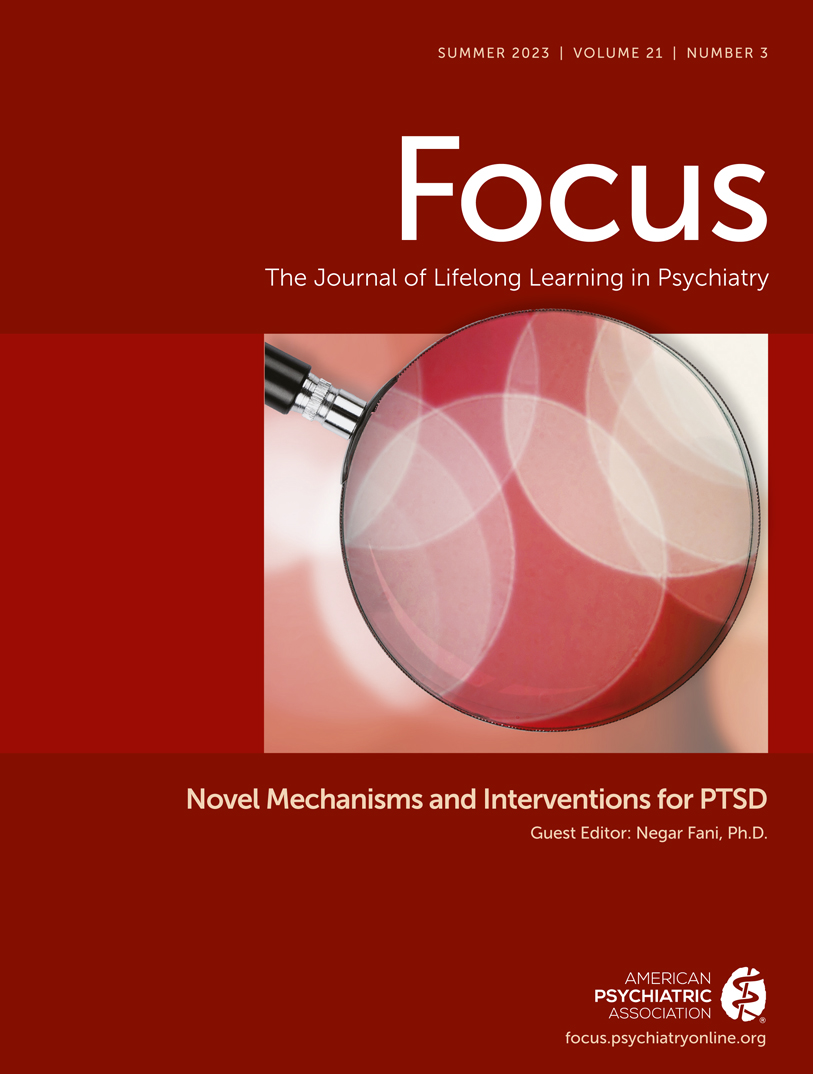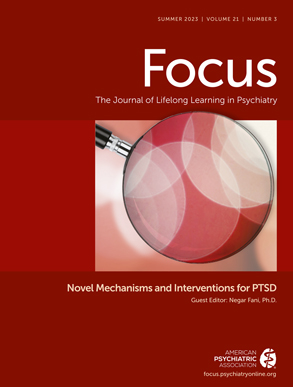One of my favorite teaching tools is a case study by Drs. Lanius, Hopper, and Menon (
1), who present multimodal (clinical, psychophysiological, neuroimaging) data from a husband and wife who were trapped in their car during a severe motor vehicle accident. Although these life partners went through the same experience, they had completely different subjective and neurobiological responses—from heart rate to brain activation—both at the time of the trauma and in response to a first-line treatment for posttraumatic stress disorder (PTSD): prolonged exposure therapy. It is amazing to see their divergent reactions to the same event, and equally interesting to hypothesize how socioenvironmental features of their development, including parent-child interactions, might have influenced these responses. This example brings to light the diversity in trauma response that makes PTSD such a complex, nuanced disorder.
The authors in this special issue of Focus bring unique perspectives to this complex disorder and describe innovative ways to treat the different manifestations of PTSD. In their detailed review, “Assessment of Traumatic Stress Symptoms During the Acute Posttrauma Period,” Zoe Brier, M.A., and colleagues discuss predictors of PTSD development in the aftermath of trauma, bringing attention to factors that influence recovery trajectories, including histories of marginalization and interpersonal trauma as some of the most salient factors that influence increased risk for PTSD symptom development. Brier et al. bring forth the utility of mobile technologies (i.e., smartphones and wearable sensors) in predicting PTSD onset as well as considerations for their use. The authors discuss the need for thorough education on the type and nature of data that are being collected, as well as ethical considerations for data analysis and interpretation. Clearly, these technologies have significant value in PTSD prevention strategies, but only if handled with careful deliberation on their use, particularly with marginalized groups. Brier and colleagues review an acute posttrauma mental health program, the Trauma Resilience and Recovery Program (TRRP), which uses mobile technologies to effectively identify individuals who may need further support in the aftermath of trauma (i.e., within 30 days of reporting the trauma) and refer them to appropriate trauma treatments. The success of TRRP initiatives makes it clear that we have made great strides in PTSD prevention and early intervention.
We are also learning more about how dysregulation in interoceptive processes—the awareness and interpretation of visceral afferents—have played a role in PTSD symptom development and maintenance. In their article, “Interoception in Fear Learning and Posttraumatic Stress Disorder,” Sonalee Joshi, Ph.D., and colleagues describe the role of interoceptive disruptions in posttraumatic pathology, referencing a theoretical model proposed by Kearney and Lanius (
2) that describes how specific internal signals become associated with threat in the context of trauma. These associations can perpetuate fear-related responses as well as emotional numbing and reactive detachment from the self. Interventions for interoceptive disturbances range from exposure-based therapies to mind-body interventions; these include mindfulness practices and Flotation and Reduced Environmental Stimulation Therapy, which may facilitate interoceptive awareness by attenuating exteroceptive sensory input. It is time for more research to be conducted on the mechanisms and efficacy of such novel mind-body interventions for PTSD.
Another key reason for innovation in PTSD treatment is the relatively high attrition rates for trauma-focused treatments (
3); this reflects a clear need for alternative approaches. Psychedelic-assisted treatments, including augmentation with ketamine and 3,4-methylenedioxymethamphetamine (MDMA), hold promise in addressing some of the most treatment-resistant manifestations of PTSD, including anhedonic features, as referenced in this issue’s Ask the Expert, “Treating Motivational and Consummatory Aspects of Anhedonia,” by an international expert in the assessment and treatment of anhedonia, Michael Treadway, Ph.D. In addition to augmenting fear extinction in the context of exposure therapies, these treatments have significant promise for other salient features of PTSD. The neuroplastic effects of ketamine and MDMA can facilitate openness to experience and more flexible ways of thinking about the trauma. Individuals with PTSD may start to take a more compassionate perspective toward themselves, consider more nuanced considerations of the event, or develop less biased ways of thinking about people. For example, a sexual assault survivor may be open to less rigid perspectives about people who bear similarities to their assailant (e.g., generalizations about people of the same gender as the assailant). As emphasized by Benjamin Lewis, M.D., and Kevin Byrne, M.D., in “A Review of MDMA-Assisted Therapy for Posttraumatic Stress Disorder,” given that MDMA also causes an increase in oxytocin release, this has implications for building feelings of trust and safety with other people, enhancing social reward. In “Ketamine for Treatment of Posttraumtic Stress Disorder: State of the Field,” Rachel Fremont, M.D., Ph.D., et al. explore how ketamine also has clear effects on reward circuitry, which is especially salient for people with PTSD who have more emotional numbing or posttrauma anhedonia. Although there are important considerations for people with substance use disorders, these treatments may be administered safely, minimizing risk for adverse effects and psychedelic misuse.
Expanding the representation of trauma-exposed participants from different racial-ethnic and socioeconomic backgrounds in these trials should be a priority, as well as optimal scaling of treatments to enhance feasibility. Minoritized (in particular, Black and Brown) individuals may experience more skepticism toward these interventions and feel concern that their emotional and physical vulnerability during the sessions will be exploited by psychiatry researchers. These fears are not unfounded—they have a clear historical context (
4). Addressing these concerns can start with community conversations and can continue with multifaceted training of therapists and researchers to ensure ethical decision making, with continued bidirectional communication between participants and researchers. Mixed-methods designs are particularly valuable in understanding the ways in which these pharmacological interventions create positive change, as well as areas for improvement.
Clinicians and scientists, take heart—this spectrum of research shows us that we have the tools to effectively assess and treat PTSD in all its forms—as long as we thoughtfully consider both the individual’s unique symptom presentation and socioenvironmental factors when selecting the best treatment. This is an exciting time to be a clinician-researcher, with so many breakthrough, novel treatments emerging at a rapid pace. Likewise, it is a time for people with PTSD to be hopeful, as the right treatment for them may be just around the corner.

